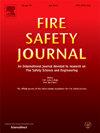AFFF foam fire extinguishing by gas-permeated spreading and flame barrier with different foaming gases
IF 3.4
3区 工程技术
Q2 ENGINEERING, CIVIL
引用次数: 0
Abstract
Currently, there is a lack of delicate research on flame suppression by foam spreading on the fuel surface. In this study, we propose a new method of varying the foaming gases to control the foam spreading rate on oil surfaces. The kinetic process of foam extinguishing with various gas-liquid ratios is investigated. In addition, the synergistic effect of gas-permeated spreading and flame barrier on the extinguishing efficiency was examined. The results indicate a positive correlation between the extinguishing efficiency and the flame-free spreading rate of CO2 > He > Ar > N2 > Air. The extinguishing efficiency decreases with increasing gas-liquid ratio, while the 6:1 ratio leads to a 59% increase in extinguishing time compared to 4:1, and a 90 % increase compared to 1:1. The consumption of foam by the flame enhances as the flame-free spreading rate decreases. The flame consumes over 80% flame-free spreading rates of Air and N2 foams, leading to fast foam front consumptions by the flame and poor extinguishing performances. Gas permeation in the foam film exacerbates the bubble coalescence and foam drainage, enhancing the foam spreading performance while reducing the foam stability. The foam spreading induced by gas permeation plays a decisive role in spreading rates and extinguishing efficiency, whereas the effect of foam stability on extinguishing efficiency is less influential. Increasing the gas permeability and reducing the gas-liquid ratio enhance the overall foam mobility. Hence, the spreading rate and extinguishing efficiency increase with gas permeability. An empirical model expresses the relationship between extinguishing time and flame-free spreading rate, underscoring the decisive role of foam spreading in the fire extinguishing process.
AFFF泡沫灭火采用不同发泡气体的渗透灭火和隔焰灭火
目前,对泡沫在燃料表面扩散抑制火焰的研究尚缺乏细致的研究。在本研究中,我们提出了一种改变泡沫气体的方法来控制泡沫在油表面的扩散速度。研究了不同气液比下泡沫灭火的动力学过程。此外,还考察了气体渗透扩散和火焰阻隔对灭火效率的协同作用。结果表明:灭火效率与CO2无焰扩散速率呈正相关;他比;基于“增大化现实”技术的在氮气比;空气中。灭火效率随气液比的增大而降低,6:1的灭火时间比4:1增加59%,比1:1增加90%。火焰对泡沫的消耗随着无焰扩散速率的减小而增大。火焰消耗空气和N2泡沫的无焰蔓延率超过80%,导致火焰消耗泡沫前端快,灭火性能差。泡沫膜内气体的渗透加剧了泡沫的聚并和排泡,增强了泡沫的铺展性能,降低了泡沫的稳定性。气体渗透诱导的泡沫扩散对扩散速率和灭火效率起决定性作用,而泡沫稳定性对灭火效率的影响较小。提高透气性和降低气液比可以提高泡沫的整体流动性。因此,扩散速度和灭火效率随气体渗透性的增加而增加。一个经验模型表达了灭火时间与无焰蔓延速率之间的关系,强调了泡沫蔓延在灭火过程中的决定性作用。
本文章由计算机程序翻译,如有差异,请以英文原文为准。
求助全文
约1分钟内获得全文
求助全文
来源期刊

Fire Safety Journal
工程技术-材料科学:综合
CiteScore
5.70
自引率
9.70%
发文量
153
审稿时长
60 days
期刊介绍:
Fire Safety Journal is the leading publication dealing with all aspects of fire safety engineering. Its scope is purposefully wide, as it is deemed important to encourage papers from all sources within this multidisciplinary subject, thus providing a forum for its further development as a distinct engineering discipline. This is an essential step towards gaining a status equal to that enjoyed by the other engineering disciplines.
 求助内容:
求助内容: 应助结果提醒方式:
应助结果提醒方式:


